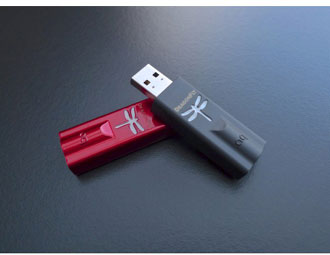Posted by Serge on 14th Apr 2016
Audioquest New Dragonfly's are arriving soon!

Audioquest shipping new Dragonfly DACs soon.
Portable USB DAC, Pre-Amp, Headphone Amp
Hard to believe! It’s been almost four years since the original DragonFly (v1.0) changed the world’s concept of what a DAC could and should be. At only $298.80, but with expensive component-quality performance, DragonFly was hailed around the world as the perfect introduction to the pleasures of high-performance audio.
A year and half later, DragonFly rocked the audio world again when we introduced the updated v1.2—for only $179.00. The sound was simply a little cleaner, a little better controlled, and more relaxed—unequivocally better. And, the new price helped bring better-sounding music to even more people. Now, AudioQuest is truly pleased to introduce two dramatic steps forward—two new DragonFlys with unprecedented audio quality and even higher performance-to-cost ratios—and, drum roll, they work with Apple and Android™ phones!
Yes, that last point is a biggie. From the day that the original DragonFly came out, they got requests for a DragonFly-quality DAC to use with smartphones. Finally, thanks to newly available parts, power draw is now well within what any phone will authorize.
Audioquest hve been busy for years making this new generation of DragonFlys possible. AudioQuest worked alongside Microchip Technology to develop a new high-performance, full-speed USB microcontroller (a DAC’s input processor) that delivers improved signal-to-noise ratio and significantly lower power consumption. Drawing 77% less current than the DragonFly v1.2’s microcontroller, the new Microchip MX microcontroller enables true compatibility with Apple and Android smartphones and tablets. For use with Apple iOS devices, Apple’s Lightning-to-USB Camera Adaptor is required; for use with Android devices, a Made for Android (OTG) adaptor, such as our DragonTail USB Adaptor For Android Devices, is required.
Audioquest hesitate to brag about specific electronic parts in the
DragonFlys because the implementation of those parts is as crucial as
their quality. Please don’t make the mistake of thinking that DACs with
the same microcontroller or primary processor all sound alike! Depending
on the circuit design, control of noise, power supply regulation,
quality of the many passive parts, etc., a supposedly “lesser” DAC chip
can easily
outperform a “better” DAC chip in a different DAC. Also,
as with cameras and their previous race to have more pixels than the
other guy, playing the numbers game can distract and deceive. While the
DAC chips in both the Black and Red DragonFlys have great capability, we
have chosen to limit DragonFly Red and Black processing to
24-bit/96kHz. This makes using the DragonFlys as simple as it’s always
been, fully compatible with PCs, etc., without having to download and
install new drivers. Though maybe more importantly, faster processing
can mean more noise, so while playing 24/192 files with some of the best
component DACs does offer sonic advantages, many DACs actually sound
better when the computer down-samples a 24/192 file to 24/96 before
sending the data to the DAC. Our point is that AudioQuest plays a
music-quality game first and foremost. DragonFlys are designed to be
the-best-they-can-be Emotional Transportation for your music, whether
Spotify, YouTube videos, Tidal, ripped CDs, or state-of-the-art Hi-Res
files.
Back to bragging about their internals: The new DragonFly models also
incorporate improved 32-bit ESS Sabre DAC chips—the 9010 in Black and
the higher-performance 9016 in Red—both of which employ minimum-phase
filtering for naturally detailed, more authentic sound. While DragonFly
Black uses the same high-quality headphone amp and analog volume control
found in the DragonFly 1.2, DragonFly Red
includes the latest ESS
headphone amp and a bit-perfect digital volume control that resides on
the 9016 DAC chip itself—a sophisticated implementation that ensures
maximum fidelity, dynamic contrast, and signal-to-noise ratio. Those of
you who remember how we bragged about the DragonFly v1.0 and v1.2 having
an analog volume control might now be going “huh?” Good question! It’s a
matter of capabilities. The earlier DragonFlys and the Black feature an
analog volume control because that’s a better-sounding approach than
most digital volume controls, which cut off bits in order to reduce the
volume. However, when a digital
volume control, as in the new
DragonFly Red, doesn’t compromise the signal, doesn’t reduce finesse and
subtlety and low-level detail, then a bit-perfect digital volume
control is superior. Once more, it’s not about a particular part or
sample rate or buzz word—it’s about honoring the quality of the
resulting sound above all else. DragonFly Black outputs 1.2 volts—enough
power to capably drive all preamplifier input circuits and all
reasonably efficient headphones. Meanwhile, with its higher 2.1-volt
output, DragonFly Red is compatible with an even wider range of
headphones, including power-hungry, low-efficiency models. For
reference, DragonFly 1.0 and 1.2 featured 1.8-volt output.
The difference in maximum output between DF Black and DF Red is
essentially irrelevant with our NightHawk headphones, as they can be
easily driven by either model, but Red’s higher output is an important
advantage with some of the more inefficient headphones on the market.
However, the difference in sound quality between the two new models is
always meaningful, and is important whether feeding
headphones or the
Aux input of an audio system. At the same volume, Red has much more
“torque,” “grip,” and “muscle” than Black. Red simply sounds cleaner and
clearer overall, enabling a larger soundstage with each instrument or
voice more nearly in its own space. And, more good news: The new
DragonFlys are software upgradeable through complimentary Windows and OS
X desktop applications. As new developments arise in music player
applications, streaming protocols, or other associated software,
DragonFly users will be able to incorporate those updates into their
existing devices.
DragonFly Black for only $129, with better sound
than any previous DragonFly for less money than any previous DragonFly,
and DragonFly Red with much better sound at only $249—and both
compatible with phones—how much good news can you stand?!
